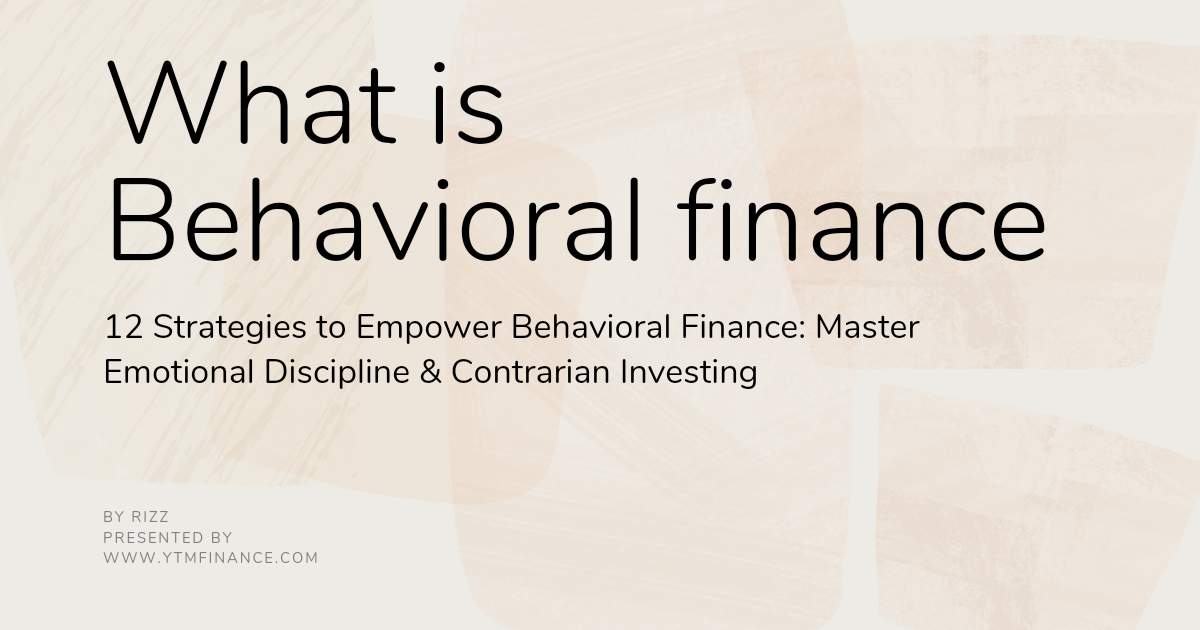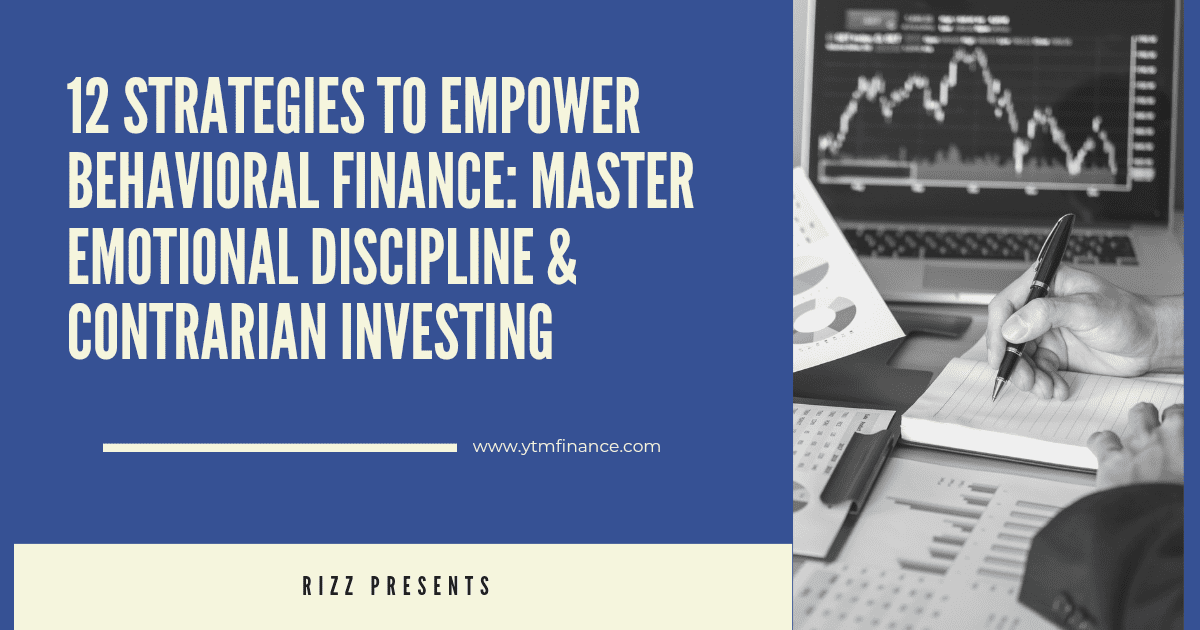Introduction:
- Introduction to Behavioral Finance: Begin with an in-depth exploration of behavioral finance, tracing its roots back to the groundbreaking work of psychologists and economists like Daniel Kahneman and Amos Tversky. Discuss how traditional finance theories often assume rational behavior from investors, while behavioral finance recognizes the influence of emotions and cognitive biases on decision-making.
- Significance of Emotional Discipline and Contrarian Investing: Delve into why emotional discipline and contrarian investing are pivotal in the realm of behavioral finance. Explain that emotional discipline helps investors avoid the pitfalls of making impulsive decisions based on fear or greed, while contrarian investing allows them to capitalize on market inefficiencies created by emotional extremes and herd behavior.
- Thesis Statement: Conclude the introduction with a thesis statement that outlines the central argument of the article: mastering emotional discipline and contrarian investing is essential for navigating the complexities of financial markets and achieving long-term investment success.
Emotional Discipline:
- Understanding Emotional Discipline: Offer a comprehensive overview of emotional discipline, emphasizing its role in helping investors maintain a rational approach to decision-making despite market fluctuations and emotional pressures.
- Biases and Their Impact: Explore a range of cognitive biases that can affect investment decisions, such as anchoring bias, overconfidence bias, and availability bias. Provide real-world examples or case studies to illustrate how these biases can lead to suboptimal investment outcomes.
- Developing Self-Awareness: Discuss strategies for investors to develop self-awareness and recognize their own biases. This could include techniques such as mindfulness meditation, keeping an investment journal, or seeking feedback from a trusted mentor or advisor.
- Practical Tips for Cultivating Emotional Discipline: Offer practical tips and advice for investors to cultivate emotional discipline in their investment approach. This could involve setting clear investment goals, establishing a disciplined investment plan, and employing techniques like dollar-cost averaging to avoid emotional reactions to market volatility.
Contrarian Investing:
- Definition and Rationale: Provide a detailed explanation of contrarian investing, highlighting its roots in value investing principles and the concept of buying when others are selling. Discuss the rationale behind contrarian strategies, including the idea that market sentiment often overreacts to short-term news and events, creating opportunities for savvy investors.
- Traits of Contrarian Investors: Explore the characteristics of successful contrarian investors, such as patience, discipline, and the ability to think independently. Draw on examples from famous investors like Warren Buffett or Seth Klarman to illustrate these traits in action.
- Implementing a Contrarian Strategy: Outline the steps involved in implementing a contrarian strategy, from identifying undervalued assets to having the conviction to buy when others are fearful. Discuss the importance of thorough research and due diligence in uncovering opportunities that may be overlooked by the broader market.
- Long-Term Benefits and Potential Risks: Discuss the potential long-term benefits of contrarian investing, such as the ability to buy quality assets at discounted prices and generate outsized returns over time. However, also acknowledge the risks involved, including the possibility of short-term underperformance and the need for patience during periods of market turmoil.
Implementing Emotional Discipline and Contrarian Investing:
- Synergy Between the Two: Explore how emotional discipline and contrarian investing can work together synergistically to enhance investment outcomes. Explain that emotional discipline provides the foundation for successfully executing contrarian strategies, as it enables investors to remain calm and rational in the face of market volatility.
- Managing Psychological Challenges: Discuss the psychological challenges that investors may encounter when practicing contrarian investing, such as dealing with social pressure to conform or coping with short-term market fluctuations. Offer practical strategies for managing these challenges while maintaining emotional discipline, such as surrounding oneself with a supportive network of like-minded investors or focusing on the long-term fundamentals of investments.
- Case Studies or Examples: Provide detailed case studies or examples of investors who have successfully combined emotional discipline with contrarian investing to achieve outstanding investment results. Highlight the specific strategies and techniques they employed, as well as the lessons that can be learned from their experiences.
Market Sentiment and Herd Behavior:
- Discuss the influence of market sentiment and herd behavior on investment decisions.
- Explore how investor psychology can lead to the formation of market bubbles and crashes.
- Offer strategies for recognizing and navigating herd behavior in financial markets.
Overcoming Overconfidence:
- Examine the phenomenon of overconfidence bias and its impact on investment decisions.
- Discuss how overconfidence can lead investors to take excessive risks or ignore important information.
- Provide techniques for mitigating overconfidence and making more rational investment choices.
Anchoring and Mental Accounting:
- Explain the concepts of anchoring bias and mental accounting, and how they affect investor behavior.
- Explore how investors may anchor on irrelevant information or compartmentalize their investments, leading to suboptimal decisions.
- Offer strategies for breaking free from anchoring biases and adopting a more holistic approach to investing.
Behavioral Biases in Portfolio Management:
- Investigate how behavioral biases impact portfolio construction and management.
- Discuss common biases such as the disposition effect and regret aversion, and their implications for portfolio rebalancing and asset allocation.
- Provide best practices for designing investment portfolios that account for behavioral biases and promote long-term wealth accumulation.
The Role of Financial Advisors in Behavioral Finance:
- Examine the role of financial advisors in helping clients navigate the behavioral pitfalls of investing.
- Discuss techniques advisors can use to coach clients towards more disciplined and rational investment behavior.
- Explore the ethical considerations of leveraging behavioral insights in financial advisory practice.
Behavioral Finance and Market Efficiency:
- Debate the implications of behavioral finance for the Efficient Market Hypothesis (EMH).
- Discuss whether markets are truly efficient or if behavioral biases create opportunities for outperformance.
- Examine the challenges and limitations of applying behavioral insights to investment strategies in an efficient market context.
Future Trends in Behavioral Finance:
- Speculate on emerging trends and developments in the field of behavioral finance.
- Discuss the potential impact of technological advancements, such as artificial intelligence and big data analytics, on understanding and managing investor behavior.
- Explore avenues for further research and collaboration in behavioral finance to address unanswered questions and refine investment practices.

Conclusion:
- Recap of Key Points: Summarize the main points covered in the article, reiterating the importance of emotional discipline and contrarian investing in successful investment strategies. Emphasize that by mastering these principles, investors can navigate the complexities of financial markets with confidence and resilience.
- Call to Action: Encourage readers to apply the principles of emotional discipline and contrarian investing in their own investment approach. Offer additional resources or further reading recommendations for those interested in learning more about behavioral finance and its practical applications in investment management.
- Closing Thoughts: Conclude the article with some final thoughts or reflections on the significance of emotional discipline and contrarian investing in the context of behavioral finance. Reiterate the thesis statement and leave readers with a sense of empowerment and inspiration to take control of their financial future.
By expanding each point and incorporating additional examples, case studies, and practical advice, the article can provide readers with a more comprehensive understanding of emotional discipline and contrarian investing within the framework of behavioral finance.

